Flowerpot made from disposable plastic cups When I first started living in the United States, what surprised me was the fact that I use a lot more disposables than I thought. It seems that there are almost no places that do not use disposable products, such as various parties, events, coffee shops, and stores. The amount of garbage thrown out like that is truly unimaginable. Maybe that's why, living with the harsh experience of recycling, I was frightened to see things that were once used and thrown away. So I brought home disposable cups, plates, and forks, washed them, and used them again. It is incomprehensible that some disposable plates are used once and then thrown away because the gilded decorations are gorgeous and beautiful. In fact, it is practical and convenient to use disposable products. It's cheap, you don't need to wash the dishes, you don't have to break it, and you don't have to worry about hygiene. Disposables from various companies come in a variety of shapes, colors, and designs, so it's hard to resist the temptation to try them out. However, such easily purchased, used and recklessly dumped garbage causes many environmental problems. In our area, there are also many issues related to recycling and landfilling. The article Long Island faces garbage crisis (Albany needs to act) details the landfill problem in Long Island, where we live. Long Island has a garbage crisis. Its 3 million residents generate about 7 pounds of solid waste per person per day – nearly twice the national average. Roughly a quarter of that is food waste. In total, the region produces about 1.4 million tons of food waste each year. Long Island’s last landfill in Brookhaven will close in 2025, and all that food waste will have to go somewhere. (except by article) The problem of landfilling is not limited to food waste. Disposable products that we use inadvertently in our daily life are also included here. When I felt that I was aware of environmental issues locally, it was when the supermarket set a price for single-use plastic bags. The bag price, which is added at $0.05 per piece, helps buyers to hesitate and use their own bag at least once. I also keep my personal shopping cart in the trunk of my car to avoid using bags at all. Just bring the entire shopping cart to my car and place it in own personal shopping cart in the trunk. I know doing this won't help much, but I can still forget the guilt of $0.05. In addition to this, schools have also begun to educate students about the environment. In the case of my daughter, at school, there was a homework assignment to make flower pots using discarded disposable products. My daughter made flower pots out of the disposable plastic cups she used for the party. A while ago, I accidentally discovered that the beans I planted here are growing beautifully. The cup was made by my child, reminiscent of the shape of a butterfly.She rolled the butterfly's antenna into a circle and glued the small plastic materials she had collected onto the cup. And they made wings out of damaged or unused toys and glued them together. After making it, I took it with me to school. Soybeans were planted with soil at school. And the bean has just sprouted. I think it was a valuable and important educational experience for the children.
0 Comments
Leave a Reply. |
Myungja Anna KohArtist Categories
All
Archives
July 2024
|
Proudly powered by Weebly









 RSS Feed
RSS Feed